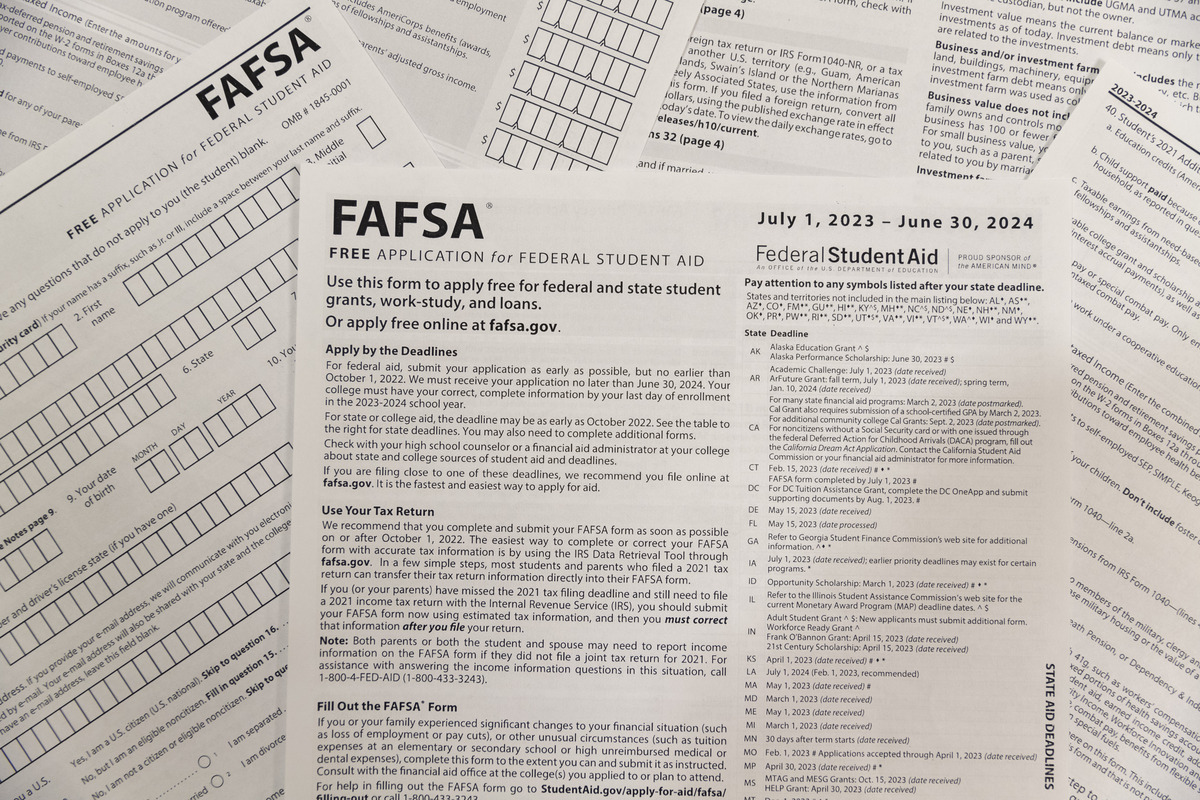The Free Application for Federal Student Aid is undergoing changes for the 2024-25 school year intended to simplify the process and adjust how aid is calculated, according to the U.S. Department of Education.
The Free Application for Federal Student Aid is undergoing changes for the 2024-25 school year intended to simplify the process and adjust how aid is calculated, according to the U.S. Department of Education.
The nationwide changes will impact the application set to release in December and are required by the FUTURE Act passed in 2019 and FAFSA Simplification Act passed in 2021, the department said in a letter to Congress.
Jessica Musial, Loyola’s director of operations and reporting for financial aid, said the FUTURE Act mandated communication between the IRS and the U.S. departments of Education and Treasury.
The bill amended the Higher Education Act and Internal Revenue Code and required incremental implementation of smaller changes such as the removal of individual application questions, Musial said.
The FAFSA Simplification Act is embedded within the FUTURE Act but doesn’t require the more sweeping changes to be implemented until the FAFSA for the upcoming school year, according to Tobyn Friar, the assistant vice president and director of financial aid at Loyola’s Financial Aid Office.
Friar said the biggest change is the required data transaction between the Internal Revenue Service and the Department of Education. Students — and their parents if the student is a dependent — must grant permission for FAFSA to pull their IRS data into the application, according to Friar.
Unlike the optional IRS Data Retrieval Tool formerly in place, Friar said the new data transaction is required for applications to be approved.
The old application divided parent contributions by the number of kids enrolled simultaneously but now, need levels will increase for families with multiple kids in college, according to Friar.
Friar said Pell Grants, which used to be awarded to full-time students based on Expected Family Contribution, are now based on the Student Aid Index calculated by FAFSA.
The Student Aid Index range includes negative numbers rather than cutting off at zero, meaning more students lower on the income scale will be eligible for Pell, but students at the top of the Student Aid Index range may lose eligibility, Friar said.
Course enrollment influences the Student Aid Index, meaning students will receive different amounts of Pell aid depending on the number of credit hours they enroll in, according to Friar.
The calculation of student need will now factor in poverty guidelines by the student’s home state, which will benefit students looking to access Pell aid because it provides them with additional criteria for becoming eligible, according to Friar.
Third-year Audrey Cenatiempo said she believes a common issue for students is the length and difficulty of filling out the FAFSA.
“I think the most common thing about the FAFSA is that it’s so long,” Cenatiempo said. “It takes forever to fill out. Me and my mom do it together, so I haven’t really dealt with the frustration of doing it by myself but if I did, I think it would be super frustrating.”
Friar said numerous changes are being made to the requirements on assets that need to be reported to FAFSA, such as the new requirement for families to report small businesses and farms, which can significantly reduce the level of need-based aid provided.
The need-based changes also require states to change their aid calculation process to match the new Department of Education methodology, meaning some Illinois residents will no longer be eligible for the Monetary Award Program Grant of $8,400, according to Friar.
In general, the changes will result in an increase in aid to low income families and a decrease to middle and high income families, according to Friar.
Friar said he doesn’t anticipate a negative impact on Arrupe College students due to the higher level of need among that student population, and Stritch and other graduate students who don’t qualify for Pell will be minimally impacted by the changes.
Friar said Financial Aid Office leadership is looking at institutional aid programs to assist some students who lose Pell aid as a result of the changes. The office is monitoring the forecasting of potential impacts on students to communicate with affected families before aid is awarded and help them make appeals.
“Allowing us an opportunity to help them I think is what’s going to be really important,” Friar said. “Because we want students to retain, we want students to graduate, and we don’t want those financial barriers to get in the way. That’s where some of the work will come into play with our evaluation of these changes.”
The Financial Aid Office is also organizing virtual and in-person workshops, video tutorials on the FAFSA application process and other informational resources for students and parents, according to Friar.
The resources can’t be provided yet because the office is still waiting to receive a final draft of the new FAFSA form from the Department of Education but will likely begin in mid-January and continue throughout the spring semester, Friar said.
Musial, who manages technical aspects of the Financial Aid Office’s work, said the Department of Education acts as a liaison between Congress and financial aid offices. She said the changes announced since the FUTURE Act’s passage include technical adjustments to accommodate IRS rules, so ensuring the added level of data security will be a new responsibility for the office.
First-year Elizabeth Sims-Wilson said her mom, who teaches juniors and seniors in high school, has encountered parents who have concerns about the information required by FAFSA.
“I know a few students’ parents were kind of iffy about putting their information in because money is such a huge topic for a lot of people,” Sims-Wilson said. “I feel like it was kind of a disclosure of your privacy, so I see some people would have an issue with it.”
Loyola’s student information system LOCUS and other related online services will be overhauled by the Financial Aid Office so they work in accordance with new Department of Education requirements, according to Musial.
While students won’t notice a difference, the updated system will allow for functionality on the administrative side including the transfer of new FAFSA data and student aid, according to Friar.
Friar said the Financial Aid Office hasn’t received an indication from the Department of Education on the exact release date for the new FAFSA form in December or a final draft of the updated form.
“It’s been difficult and frustrating in some aspects because we feel like the Department of Education has had ample time to get this ready,” Friar said. “They’ve known that this has been coming for a long time and we’re still at a lot of unknowns which is really, really too bad. It’s frustrating for institutions because ultimately it has an impact on the student.”
Musial said it would be helpful for the Department of Education to commit to a date so the Financial Aid Office can communicate it to students, but she’s in favor of the changes because they’ll improve the process of getting aid for families.
“At the end of the day, this is a tool for students and parents,” Musial said. “And if it’s going to make their application process easier and break down barriers that students or parents had while filing the FAFSA or getting student aid, then it’s worthwhile and it’s something that I’m in favor of.”
This article was written by Colin Hart
Featured image by Holden Green / The Phoenix











